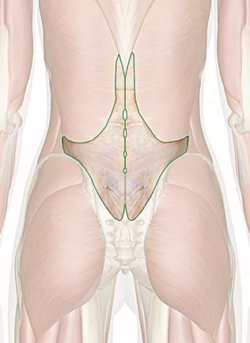Introduction to the treatment of musculoskeletal problems of the lumbar fascia with a tecar technology combined with manual technique
This short article aims to describe a “combined” approach for the treatment of musculoskeletal problems attached to the thoraco-lumbar fascia with a tecar instrument and manual technique. The primary objective of this approach is to enhance the effectiveness of manual treatment through instrumental therapy: more specifically through a tecar technology.
This contribution is part of the broader spectrum of a new multi-sectoral professional concept aimed at a fast and lasting clinical solution for the patient, no longer strictly linked to the single technique or hermetically sectorialized discipline.
Anatomical framework: the lumbar fascia
Remaining on a level of essential anatomy and without claiming to be exhaustive, we can assert that the thoraco-lumbar fascia (Img. 1), is a complex system of bundles of connective tissue that surrounds the spinal erector muscles, the multifidus muscle and the square of the loins.
The thoraco-lumbar belt is made up of three layers of fabric. The external posterior one connects the great dorsal muscle (latissimus dorsi), the gluteus maximus (gluteus maximus), the external oblique and the trapezius.

Within the different layers of tissue, there is a certain amount of matrix liquid partly made up of hyaluronic acid. This one, among the various functions, facilitates the accommodation and sliding of the different layers of fabric overlapping each other. Hyaluronic acid permeates different types of tissue from the deepest endomysium to the connective tissue of the superficial fascia and plays an important role in the biomechanics of this organ spread throughout the body.
Recent studies such as the one cited in the bibliography (Nr. 8), have recently outlined a new class of cells present in the fascia. The so-called “fasciacytes” are cells dedicated to the construction and renewal of the fascial extra-cellular matrix, high in hyaluronic acid.
Other studies (Nr. 7) attribute to these cells the ability to influence the functionality of the fascia organ and argue for their involvement in myofascial pain symptoms.
The thoraco-lumbar belt is responsible, among other things, for the balance and distribution of the forces that act between the spine, pelvis and lower limbs. In addition, during the movement phases and during walking / running, the arm and the counter-lateral leg are also included in the biomechanical action.
The constant use of this structure makes it one of the most susceptible to trauma and pathologies that are mainly linked to lifestyle. For example, a sedentary or repetitive lifestyle (spending too much time sitting, in prolonged torsion positions, etc.) can lead to insufficient activation of the musculature which consequently worsens its viscoelasticity with a consequent increase in friction between several layers of innervated tissue.
Recent studies link this worsening with a pathological thickening of hyaluronic acid in the areas from which the painful stimulus originates. This condition seems in fact to exacerbate the risk of incurring painful symptoms typical for example of non-specific lower back pain.
There are countless tests and evaluations that can be useful in case of lower back pain. This is not the place to unravel the topic exhaustively but there are some simple strategies that can help us understand if the thoraco-lumbar belt is involved in the patient’s symptoms. An example is the active flexion test: when positive, the patient will not complete flexion or at least it will be markedly limited.
The positive flexion test and the consequent limitation of movement indicate an adaptation of the vertebral structure with respective hypertonia of the sacro-spinal muscle.

Energy transfer in favor of manual therapy
The energy delivered by the instrument acts as an accelerator of the tissue responses that we believe are useful for obtaining the clinical result we are seeking. The treatment of musculoskeletal problems of the lumbar fascia with a combined tecar instrument, therefore, is structured in a first part in which the tissues are prepared for manipulation thanks to the synchronized action of pressure, traction and manual mobilization associated with the electromagnetic stimulus.
Operationally, this occurs by “forking” the handpiece of the device in such a way as to keep the electrode between the fingers while applying the manual maneuvers to the area of interest with a technique as similar as possible to that which would be applied in the absence of the handpiece.

The electromagnetic field, at certain energy levels, stimulates the increase in tissue temperature which in turn produces a significant increase in blood perfusion (as described in detail in research reports Nr. 5 and Nr. 6). The positive effects of the tecar device for cases of lower back pain are reported in several studies including the one mentioned here in the bibliography (Nr. 3).
Once acting on the viscoelasticity of the tissue, it is possible to apply mobilizations that with the aim of improving the R.O.M. joint, and stimulate the production of joint synovial fluid.
The association of mobilizations with the transfer of energy reciprocally amplifies the effects: the movement varies the resistance of the treated tissue and on the other hand accelerates the thermal response. At the same time, the temperature favors the sliding of the different layers of fabric making manual maneuvers easier. Study Nr. 4 reported in the bibliography addresses this topic. In addition to the effects on the circulatory and biomechanical level, there are also studies such as the Nr. 2 cited here in the bibliography that highlight the analgesic effects of a tecar device in cases of low back pain.
The effects on the phenomenon of flexion, relaxation and consequent analgesia
In the final stages of the session, following the combined use of energy transfer and manual therapy as described above, it is possible to associate vertebral manipulations when the case requires it.
For some examples we recommend visiting the Elysium blog where some of these practices are shown for informational purposes.
Such manipulations have a double purpose: mechanical and analgesic.
The first allows us to act on the sacrospinal muscle tone and on the overlying thoracolumbar belt.
The second is of neurophysiological origin and can be observed, through magnetic resonance imaging of the BOLD type (which highlights hemodynamic flows), when an activation / inhibition of the brain areas used for the perception of nociceptive stimuli is highlighted.
Expected outcome after the treatment of musculoskeletal problems of the lumbar fascia with a tecar instrument
For a case of nonspecific lower back pain whose cause lies in a dysfunction of the thoraco-lumbar belt, a treatment carried out according to the above guidelines should give a significant improvement of the symptoms already starting from the first session. In three sessions the painful symptom must have practically disappeared. Otherwise it will be necessary to re-evaluate the patient to determine any other causes that escaped the initial diagnosis.
Bibliography
1. Comparison among different therapeutic techniques to treat low back pain: a monitored randomized study
2. Clinical Effects of Capacitive Electric Transfer Hyperthermia Therapy for Lumbago
3. Short term efficacy of capacitive-resistive diathermy therapy in patients with low back pain: A prospective randomized controlled trial
4. Effect of Capacitive and Resistive electric transfer on changes in muscle flexibility and lumbopelvic alignment after fatiguing exercise
5. Effect of Capacitive and Resistive electric transfer on haemoglobin saturation and tissue temperature
6. Does the Application of Tecar Therapy Affect Temperature and Perfusion of Skin and Muscle Microcirculation? A Pilot Feasibility Study on Healthy Subjects
7. Hyaluronan within fascia in the etiology of myofascial pain
8. The fasciacytes: A new cell devoted to fascial gliding regulation
The following article about treatment of musculoskeletal problems of the lumbar fascia with a tecar instrument was written by our Wintecare specialist Lorenzo Sportolari.




